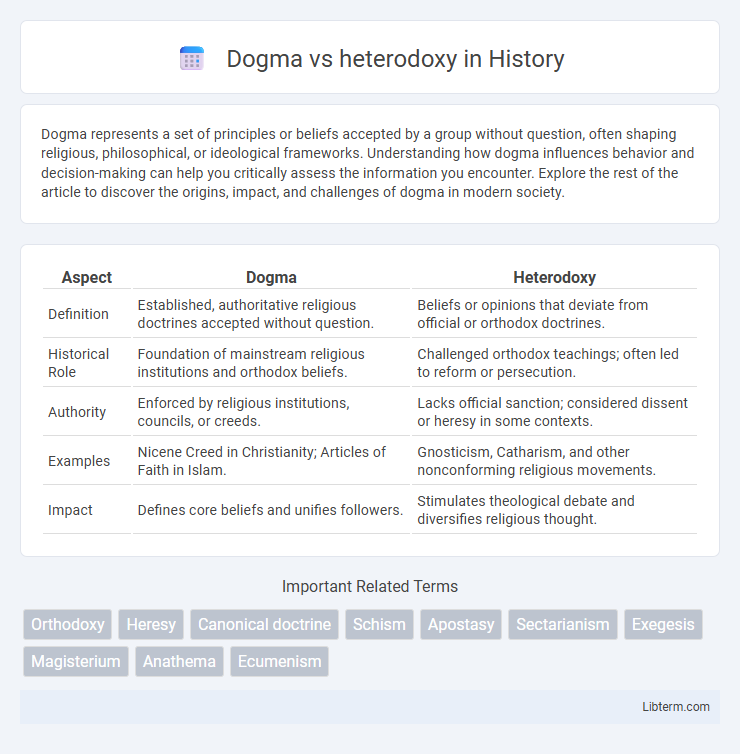Dogma represents a set of principles or beliefs accepted by a group without question, often shaping religious, philosophical, or ideological frameworks. Understanding how dogma influences behavior and decision-making can help you critically assess the information you encounter. Explore the rest of the article to discover the origins, impact, and challenges of dogma in modern society.
Table of Comparison
| Aspect | Dogma | Heterodoxy |
|---|---|---|
| Definition | Established, authoritative religious doctrines accepted without question. | Beliefs or opinions that deviate from official or orthodox doctrines. |
| Historical Role | Foundation of mainstream religious institutions and orthodox beliefs. | Challenged orthodox teachings; often led to reform or persecution. |
| Authority | Enforced by religious institutions, councils, or creeds. | Lacks official sanction; considered dissent or heresy in some contexts. |
| Examples | Nicene Creed in Christianity; Articles of Faith in Islam. | Gnosticism, Catharism, and other nonconforming religious movements. |
| Impact | Defines core beliefs and unifies followers. | Stimulates theological debate and diversifies religious thought. |
Understanding Dogma: Definition and Origins
Dogma refers to authoritative religious or philosophical teachings deemed unchallengeable by a specific community, often rooted in historical traditions and established doctrines. Its origins trace back to early religious councils and formalized creeds that aimed to unify belief systems and prevent doctrinal fragmentation. Understanding dogma involves recognizing its role in defining orthodoxy and maintaining consistent ideological frameworks within societies.
What is Heterodoxy? Key Characteristics
Heterodoxy refers to beliefs or doctrines that deviate from established dogma, challenging orthodox principles within a religious, philosophical, or ideological system. Key characteristics of heterodoxy include the rejection of authoritative doctrines, openness to alternative interpretations, and a tendency to promote diversity of thought and critical inquiry. This concept often implies a dynamic and evolving approach to belief, contrasting with the rigid and fixed nature of dogma.
Historical Conflicts: Dogma vs Heterodoxy
Historical conflicts between dogma and heterodoxy often centered on the enforcement of orthodox religious beliefs against divergent interpretations, leading to significant schisms and doctrinal councils, such as the Council of Nicaea in 325 AD which defined the dogma of the Trinity. These clashes shaped ecclesiastical authority by marginalizing heretical views and solidifying creedal statements that guided theological orthodoxy for centuries. The tension between dogma and heterodoxy illustrates the dynamic process of defining and defending core religious doctrines in response to evolving theological challenges.
The Role of Authority in Shaping Beliefs
Dogma relies on established authority to define and enforce core beliefs, ensuring uniformity and stability within a tradition or institution. Heterodoxy challenges these authoritative doctrines, promoting alternative interpretations and critical examination of accepted truths. The tension between dogma and heterodoxy highlights how authority shapes belief systems, influencing both conformity and innovation in religious, philosophical, and ideological contexts.
Dogmatic Systems in Religion, Science, and Society
Dogmatic systems in religion, science, and society establish fixed doctrines or principles considered incontrovertibly true, shaping belief frameworks and guiding behavior with rigid authority. In religion, dogma dictates core theological tenets such as the Nicene Creed in Christianity, enforcing uniformity and orthodoxy among adherents. Scientifically, dogmatism can hinder progress by resisting paradigm shifts, while societal dogmas often manifest as unchallenged cultural norms or political ideologies that influence collective identity and decision-making.
Heterodoxy as a Catalyst for Change
Heterodoxy challenges established dogma by introducing alternative viewpoints that stimulate critical thinking and innovation. This divergence from orthodox beliefs often serves as a catalyst for social, cultural, or scientific transformations, driving progress and adaptation. Embracing heterodox ideas can dismantle rigid frameworks, fostering an environment where change becomes possible through the reevaluation of accepted norms.
Social Consequences of Challenging Dogma
Challenging dogma often results in social ostracism, resistance, and conflict as established institutions defend prevailing beliefs to maintain cohesion and authority. Heterodox views can disrupt societal norms, prompting debates that challenge power structures and encourage intellectual diversity. Over time, the social consequences of confronting dogma may foster innovation, reform, and greater pluralism within communities.
Case Studies: Famous Heterodox Thinkers
Famous heterodox thinkers like Galileo Galilei challenged prevailing dogma by advocating heliocentrism despite the Catholic Church's geocentric doctrine, demonstrating the conflict between established orthodoxy and innovative ideas. Similarly, Friedrich Nietzsche's critique of traditional Christian morality questioned dogmatic values, promoting a re-evaluation of ethics and culture. These case studies highlight how heterodox perspectives often drive intellectual progress by opposing rigid dogma in philosophy, science, and religion.
The Balance Between Tradition and Innovation
Dogma represents established beliefs maintained rigidly within religious or ideological frameworks, while heterodoxy embraces innovation and challenges traditional doctrines. Maintaining a balance between tradition and innovation involves respecting foundational dogmas that provide identity and continuity, while allowing heterodox perspectives to foster growth and adaptation to contemporary contexts. This dynamic interplay ensures the vitality of belief systems by preventing stagnation and encouraging thoughtful evolution.
The Future of Dogma and Heterodoxy in a Globalized World
The future of dogma and heterodoxy in a globalized world will involve dynamic interactions between established doctrines and emerging alternative beliefs shaped by cultural exchanges. Increased connectivity promotes cross-cultural dialogue, challenging rigid dogmatic frameworks while fostering pluralism and reinterpretation of traditional tenets. Sociopolitical factors and technological advancements will further influence how dogma persists and heterodox ideas gain legitimacy across diverse societies.
Dogma Infographic

 libterm.com
libterm.com